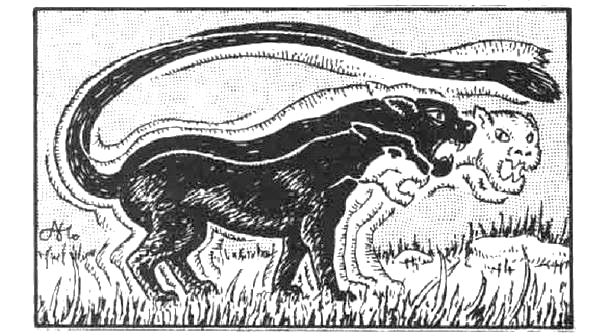I’ve never used the Nilbog due to its basic premise. I mean,
within the general parameters of Advanced Dungeons & Dragons,
this is a monster that is hard to make anything more than a mean-spirited
“gotcha”. I think that Dungeon Crawl
Classics may be more robust in this regard, in that patrons and divine intervention are baked into the rules, and might provide a party of harried adventurers at least some control over their actions. That nilbogism affects the area around the Nilbog is also baked into the text, but if the signs you have entered such a dangerous zone make you want to retreat, the chances are that you are only going deeper.
There is nothing intrinsically wrong with the Nonafel, but the creature (as it appeared in the Fiend Folio) was a bit hard to run, and never really grabbed me. I have cleaned it up a bit here, and I hope that it grabs you. If you use this version of the Nonafel, or used the Fiend Folio version, I would love to hear about it. Likewise the Nilbog. There have to be some really great stories out there, which will add a whole new dimension to my gaming!
As with the previous post, if you are enjoying these conversions, and feel like tipping, please consider supporting my Patreon. There is a $1 per month “tip jar” option, but October is Halloween Month and I have plans for the backer rewards.
Nilbog
Nilbog: Init
-1; Atk bite -1 melee (1d3) or as weapon -1 melee; AC 10 + armor; HD 1d6-1; MV 20’;
Act 1d20; SP infravision 60’, nilbogism; SV Fort -2, Ref +1, Will -2; AL L.
Many and varied accounts have been received about the nature of the space-time disturbances which take place in the presence of nilbogs. Only one factor appears to be common – those who encounter a nilbog have no control over their own actions and will generally pursue courses of action contrary to their normal intent. For example they may feel an overwhelming compulsion to load all their treasure into an empty treasure chest in the nilbog lair and leave empty-handed. There are no saves against these effects, nor is there any known defense, although patrons and gods may be able to offer some assistance there.
Another curious feature of nilbog power is that the creature gains hit points when it is struck, equal to the damage rolled. It only loses hit points by such means as a clerics Lay on Hands, forcibly feeding it healing potions, and the like.
For obvious reasons, encounters with these strange creatures are dreaded. Where nilbogs have been encountered, normal goblins tend to be treated with extreme caution, as there appears to be no way to distinguishing between normal goblins and nilbogs, save by creative spell use or trial and error.
Judges who include nilbogs in their adventures need to be ready both with generalized distortion of the space-time continuum (rabbits eating wolves, flowers pollinating bees, and so on), as well as being ready to ad-lib how the aura of nilbogism distorts the PCs’ actions from their stated intents. The judge should determine how far these effects extend from the creature (3d10 x 10’ to 1d6 miles). Finding a way to defeat a nilbog is more a mental puzzle than a tactical challenge.
Nonafel
Nonafel (Parent): Init +5; Atk Tail +7 melee (2d10) or bite +5 melee (1d8) or claw +3
melee (1d5); AC 15; HD 9d8; MV 50’; Act 1d20; SP Disassociate, regenerate when
reintegrated; SV Fort +4, Ref +8, Will +5; AL C.
Also known as a cat o’ nine tails, this carnivorous feline monster resembles a large black panther with yellow, bloodshot eyes. Their secondary name comes from their unusual dissociative power, which enables them to divide into nine individual black panthers, or to reintegrate back into a single creature. This power doesn’t use an Action Die, is almost instantaneous, and appears to be instinctive.
Dissociation: The “parent” creature turns into nine “child” creatures, each of which appears within 5’ of another. They share the same mind, and can coordinate their actions, usually attempting to surround prey so that it cannot escape. The parent beast has 9 Hit Dice, each child 1 Hit Die. When the creature dissociates, the parent's hits will be divided as equally as possible between the children (so a parent of 49 hits will divide into five children with 5 hits each and four with 6 hits each; judges are encouraged to calculate an unwounded baseline ahead of time). A parent nonafel dissociates every 1d3 rounds (1 indicating the first round of combat, or the first round of reintegration).
Reintegration: If one or more of the “children” are damaged during melee there is a 1 in 4 non-cumulative chance each round that the creature will reintegrate to form the parent creature, so long as no child creature is more than 20’ from another. This does not take an Action Die, and occurs at the end of the round (after normal attacks). Dead children also disappear, reintegrated into the whole. When reintegrated, the parent regenerate 1 hp per round per surviving child (up to 9 hp). There is a new dissociation in 1d3 rounds, which, if a child is killed, results in fewer offspring. The bodies of slain children do not reappear.
Although they can use claws and bite, the nonafel’s most devastating attack is its long flail-like, which it swings over its head to strike targets in front of it.
When a disassociated nonafel is slain, it always reverts to its parent form; there are never multiple feline corpses left behind. This is unfortunate, as the skin of these creatures can fetch up to 150 gp if undamaged…and each hit point of slashing damage done to it (for example, by swords or axes) reduces its value by 1 gp.



No comments:
Post a Comment